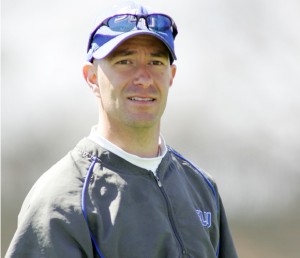Jon Bell has a tough job as the head coach of cross country and track and field at Saint Louis University. Besides the struggles of holding the campus’ attention in a sports ADD world, his athletes compete in the shadow of men’s basketball and in relative ambiguity.

But over the last five years, the Billikens have been running better than before. Driven by individual success both in cross country and track and field, Bell’s programs are competing at a level unseen at SLU.
So far in the 2011 cross country season, senior Hilary Orf has broken the school record in the 5K, and three Billikens have been named Atlantic 10 Conference Rookie of the Week. Last year, Orf claimed All-Conference honors for the second consecutive year, while freshman Margo Richardson became the first Billiken runner to nab A-10 Rookie of the Year.
In track and field, last year Bell helped Justin Kwasa (weight throw) and Brittney Cloudy (long jump) claim A-10 individual titles. In addition, a record six student athletes claimed All-Conference honors. Dahmar Smiles successfully defended his 110-meter A-10 title at the A-10 outdoor meet in 2011, and he became the first Billiken to advance to a NCAA Outdoor Track and Field quarterfinal.
In essence, Bell is building a juggernaut.
“It starts with Chris [May] and having the support of your administration,” Bell said of the success of the program. “This isn’t basketball or football. It’s a sport that you don’t see a lot of, except in Olympic years. So, it presents a challenge.
“Where do we go from there? The thing here at SLU is, typically, the cross-country are more the academic type, so having an institution that’s already academically oriented, it lends itself to [recruiting runners].”
Dropped twice as a program at SLU, cross country re-emerged in 1992, but it operated as an after-thought, not a contender. Bell was named interim head coach in 2007 and took full control of the teams a year later. Since his arrival on SLU’s campus, Bell has sent four Billikens to the USA Junior Track and Field Championships. The above statistics tend to go unnoticed, however, in a sports world dominated by ESPN highlights and tailgating. Bell says he worries about his athletes getting recognized when their achievements are not as glamorous as, say, March Madness.
“I struggle with it, but I try to stay positive about it,” Bell said. “Getting mad and upset about it isn’t going to get me anywhere. Our kids struggle with it because they work hard, they are good athletes, and they are good at what they do. You know, sometimes, they don’t get that recognition.
“One of the things I believe in is if I’m able to build a good product, people will listen. If all of a sudden, we’re sending kids to the NCAA Championships or going to the Olympic trials, people are going to notice that.”

He points to former Arkansas coach John McDonnell – who coached 23 Olympians and garnered 43 national championships – as a testament to his philosophy. “It took him 12 years to get some traction. Once you get that traction, you can run with it,” Bell said.
Adding to the program’s already budding success is the addition of the SLU Medical Center Stadium. Finally, the running, throwing and hurdling Billikens have a home.
“The kids have something they can call their own,” Bell said. “We are going to host a meet in the spring. It’s exciting for the kids, their families and the alumni, who had a lot of fun with [track and field] but never got to have their own place on campus.
“From a development standpoint, I can actually have a hurdle practice with more than six hurdles. That’s a first.”
And for Bell, it may be the final addition needed to get his program to the top of the Atlantic 10.
“Where else can you go somewhere and get a great education and compete at a high level?” he mused. “There aren’t a lot of schools that you can do both.”










